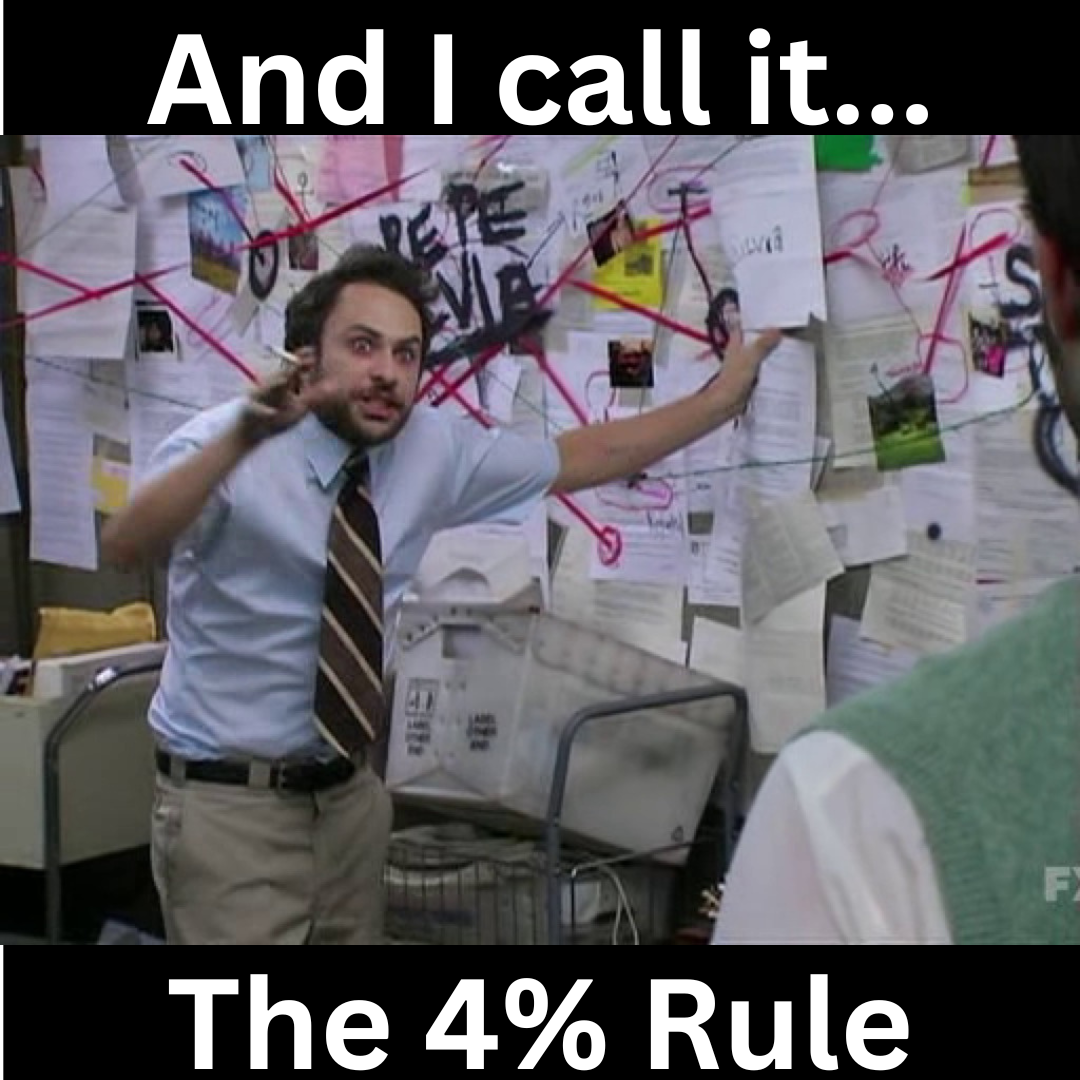One of the most highly debated and widely discussed retirement planning strategies is the 4 Percent Rule. This rule is used by financial advisors and retirees alike to determine how much money an individual needs to retire comfortably.
In this article we’ll answer some key questions about the 4 Percent Rule:
- What is the 4 Percent Rule?
- Does it Actually Work?
- How Do You Calculate it?
What is the 4% Rule for Retirement?
The 4% rule is a widely used retirement planning strategy that basically says that someone can safely withdraw 4% of their retirement portfolio each year and not run out of money. This of course can have tax implications so it is generally best practices to withraw Long Term Capital Gains instead of Short Term.
This rule is based on historical market returns and has been widely adopted as a safe withdrawal rate for retirees. The 4% rule assumes that an individual has a diversified portfolio of stocks and bonds and can expect to earn a long-term average return of 7% to 8% on their investment. The 4% Rule was first made famous by The Trinity Study.
The Trinity Study and the Four Percent Rule
The Trinity Study is a famous research paper in the field of retirement planning that helped establish the 4% rule as a widely accepted guideline for determining a safe withdrawal rate. The study was conducted by three professors at Trinity University in Texas: William Bengen, David Blanchett, and Philip Cooley.
The Trinity Study analyzed historical stock and bond market data from 1926 to 1995 and concluded that a portfolio consisting of 50% stocks and 50% bonds, with an initial withdrawal rate of 4%, had a high likelihood of lasting for at least 30 years. This conclusion was based on the assumption that the withdrawal rate would be adjusted annually for inflation.
The 4% rule has since become a widely recognized guideline for retirees to determine their safe withdrawal rate, although it’s important to keep in mind that past performance is not a guarantee of future results and that other factors, such as an individual’s age, spending habits, and portfolio mix, can impact the sustainability of retirement income.
Does the 4% Rule Really Work?
The basic idea is that you can safely withdraw 4 percent of your portfolio and never run out of money. The math is actually pretty simple, average a 7% return on investments, take out 4% and that leaves 3% left over to cover inflation.
The main problem is that the 4 percent rule relies on assumptions and historical data and for any given year, the stock market return (or loss) and inflation might be wildly different than the historical averages. 2022 was an extreme example of this where the stock market went down about 20% and inflation went up about 6.5%.
For the 4% rule to work, years like 2022 need to be an anomaly and the average returns of the stock market, as well as inflation need to return to their historical averages.
Is 4% a Safe Withdrawal Rate?
The safe withdrawal rate (SWR) is the amount that you can withdraw annually from your retirement savings without running out of money. It is a crucial factor to consider when planning for retirement, as it helps determine the sustainability of your retirement income.
The traditional rule of thumb for the safe withdrawal rate is 4% of your initial retirement savings, adjusted annually for inflation. However, this figure is based on historical stock and bond market returns and may not hold true in the future.
It’s important to understand that the safe withdrawal rate can vary depending on a number of factors, including your age, the size of your retirement savings, the investment mix in your portfolio, and your spending habits. A financial advisor can help you determine a personalized safe withdrawal rate based on your individual financial situation.
It’s also crucial to have a plan in place for dealing with market downturns, inflation, and other potential challenges to ensure that your retirement savings last throughout your lifetime.
4 Percent Rule Calculator
Yearly spending limit:
Monthly spending limit:
The 4% Rule can be Calculated in Two Different Ways:
The Standard 4 Percent Rule:
This method involves determining the amount of savings you will have at retirement, and then multiplying that figure by 4% to determine your annual withdrawal amount.
For example, if you have $500,000 saved for retirement, you would multiply $500,000 by 4% to arrive at an annual withdrawal amount of $20,000 ($500,000 x 0.04 = $20,000).
This approach is based on the assumption that you will withdraw 4% of your savings in the first year of retirement, adjust the withdrawal amount annually for inflation, and continue this withdrawal rate for a period of 30 years or more.
The Inverse 4 Percent Rule:
The Inverse method is also known as the 25x Rule for Retirement involves determining the amount you expect to spend annually in retirement and then multiplying that figure by 25 to determine the size of the retirement portfolio you will need.
For example, if you expect to spend $20,000 per year in retirement, you would multiply $20,000 by 25 to arrive at a retirement portfolio of $500,000 ($200,000 x 25 = $500,000).
4% Rule vs Inverse 4% Rule
$500,000 x 4% = $20,000
$20,000 x 25 = $500,000
Factors that Affect the 4% Rule
The 4% rule is a useful tool for retirement planning, but it is important to note that it is based on historical market returns and may not hold true in the future. The following are some factors that can affect the 4% rule and the amount you need to retire comfortably:
Market performance: The performance of the stock market and the return on your investments will affect the amount you can safely withdraw each year. A downturn in the market can reduce the value of your portfolio, leading to a lower withdrawal rate.
Inflation: Inflation is a measure of the increase in prices over time and can significantly impact the amount you need to retire comfortably. The 4% rule assumes a 3% inflation rate, which has been the average for decades but was much higher in 2022 and 2023.
Longevity: The average lifespan of individuals is increasing, leading to longer retirement periods. This can affect the amount you need to retire comfortably and may require you to save more or reduce your withdrawal rate.
Social Security: Social Security is a significant source of retirement income for many individuals. The amount you receive from Social Security can impact the amount you need to retire comfortably.
Four Percent Rule and FIRE Financial Independence
The 4% rule is often used as a starting point for retirement planning, and many FIRE enthusiasts may use a lower withdrawal rate to ensure that their portfolio lasts longer. For example, some FIRE proponents may use a withdrawal rate of 3% or 2.5% to provide a larger margin of safety and ensure that their portfolio lasts through their lifetime. It all depends on which type of FIRE you’re going for. You can also work part time (BaristaFIRE) so that you can give yourself some extra leeway.
So while the 4% rule can be a useful starting point for FIRE planning, it’s important to consider your own financial situation and goals, and to be flexible and adjust your withdrawal rate as needed. Working with a financial advisor or retirement planning specialist can help you determine the right withdrawal rate for your specific needs and goals.
4% Rule Variations
Dynamic Withdrawal Strategy:
This strategy adjusts the withdrawal amount based on the performance of your portfolio. In years where your portfolio performs well, you can withdraw more than 4%. Conversely, in years where your portfolio doesn’t perform well, you may need to withdraw less than 4%. If you can be flexible with your fixed expenses, then you will not NEED to withdraw the full 4% every year.
Another way to achieve a Dynamic Withdrawal Strategy is to not take the inflation increase in a down year.
For example, if you have $1,000,000 in year 1 then the 4% Rule will give you $40,000 to withdraw for that year.
With an average inflation rate of 3%, you can then withdraw 4% from $1,030,000 which is $41,200 which is an increase of $1,200 from the previous year.
However, if the stock market was down this year, then don’t give yourself the 3% increase. Keep your withdrawals at the same amount as last year. This will help balance things out in a down year and give you a sense of control over the situation.
Pros and Cons of the 4 Percent Rule
Pros:
Simple and easy to understand: The 4% rule is a simple and straightforward guideline for retirement planning that is easy for most people to understand and apply.
Provides a starting point: The 4% rule provides a good starting point for retirement planning, allowing individuals to estimate how much they need to save and how much they can safely withdraw.
Historically proven: The 4% rule is based on historical data and has been shown to be effective in providing retirement income for many retirees over the years.
Offers flexibility: The 4% rule offers a flexible approach to retirement planning, allowing individuals to adjust their withdrawals based on their changing financial needs and market conditions.
Provides peace of mind: Following the 4% rule can provide retirees with peace of mind, knowing that they have a reliable source of retirement income that is likely to last throughout their retirement.
Cons:
Assumes a static withdrawal rate: The 4% rule assumes a static withdrawal rate, which may not be appropriate for retirees who have changing financial needs or who experience significant market fluctuations.
May not be appropriate for all retirees: The 4% rule may not be appropriate for all retirees, especially those who have significant debt, health issues, or other financial obligations.
Doesn’t account for inflation: The 4% rule doesn’t account for inflation, which can erode the purchasing power of retirees’ savings over time.
Doesn’t consider taxes: The 4% rule doesn’t consider taxes, which can have a significant impact on retirees’ income and spending.
Relies on past performance: The 4% rule is based on historical data and may not be applicable to future market conditions or changes in the economy.
Overall, the 4% rule can be a useful starting point for retirement planning, but it’s important to consider all factors that may affect your retirement income and consult with a financial advisor to determine the best approach for your individual situation.
Wrapping Up: Is the 4% Rule a Good Idea?
It’s important to remember that this rule is a general guideline and shouldn’t be taken as gospel. Over the long run, the four percent rule works, but it will not be a linear path. There will be up years and down years in the sock market. There will also be unexpected events like possible wars, pandemics, natural disasters, terrorists attacks, etc. In the moment, these will all seem like they are the end of the world, but if you keep in mind the long term data of the stock market and long term inflation data that the rule is based on then it doesn’t seem as scary.
This rule is meant for retirement and retirement requires a long term horizon. If you’ve done your 4% Rule Calculation and are not happy with the amount that you can spend each year then you might want to consider another option like Barista FIRE. This method supplements your retirement withdrawals with extra income which can give you a much better chance of success as well as a sense of purpose and something to do in your retirement years.


Maths on the inverse method are wrong
Thanks for pointing out the typo CJ! I fixed it and have another article here all about the inverse 4 percent rule:
https://thecasualcapitalist.com/25x-rule-for-retirement/